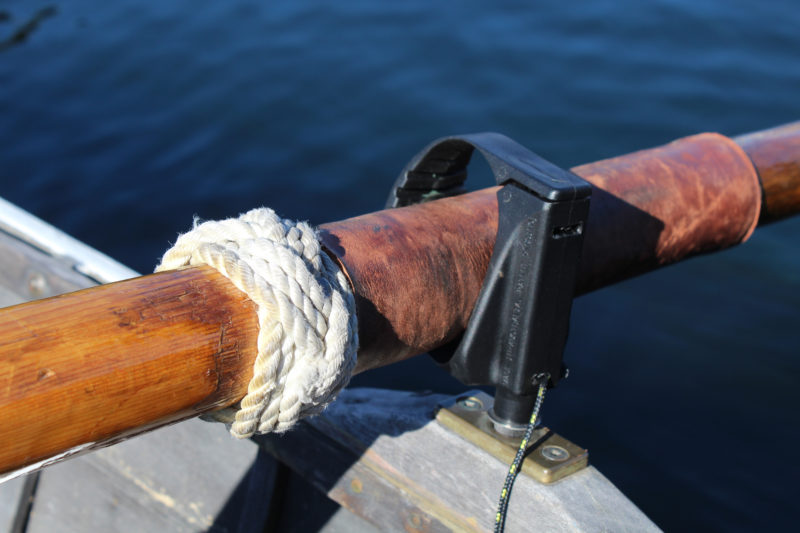 photos and video by the author
photos and video by the authorGaco oarlocks apply the mechanics of racing oarlocks to recreational rowing.
I had been curious about Gaco oarlocks for a long time, and finally decided to buy a pair to see how well they work. Instead of rotating in the socket like a normal oarlock, the Gaco’s molded copolymer cradle for the oar rotates around the pin. That’s how locks on racing shells work, and it eliminates the kind of wear that leads to a sloppy fit for conventional oarlocks. I rowed my sneakbox from Pittsburgh to Cedar Key, Florida, using conventional bronze oarlocks, and after two-and-a-half months of rowing the pins and sockets had worn considerably, even though I greased them every day, often more than once a day. As a consequence, the locks developed a lot of play, my catch wasn’t as crisp as it should have been, and the rowing was noisy.
Whatever wear there is in a Gaco lock is likely to occur much more slowly. The pin of a standard lock acts as a lever against the sides of the socket, and the pressure at the top of the socket and pin can be more than double the pressure applied by the loom against the horn; the place where the pressure is highest is also where friction occurs. The Gaco lock separates the pressure and the friction: The bottom of the pin still pries in the socket, but the friction occurs at the top of the pin directly forward of the oar and is spread over a much broader area.
I’ve never been a fan of circular oarlocks that are fixed to the oars. When the oars are shipped, the locks have to come with them, so I needed to change the way I handled the oars. Instead of taking hold of the looms to set them in the locks as I’ve been accustomed to, I grab the locks instead and the oars come along as I set the pins in the sockets. My other complaint about round oarlocks is the damage they do when they slide down the loom and hit the roots of the blade. On my spoon-bladed oars that’s a particularly difficult area to carve, and it looks good only if dings left by the oarlock aren’t spoiling the lines. The Gaco locks, at 6 oz each, are a bit lighter metal equivalents, and the plastic isn’t as apt to leave a mark.
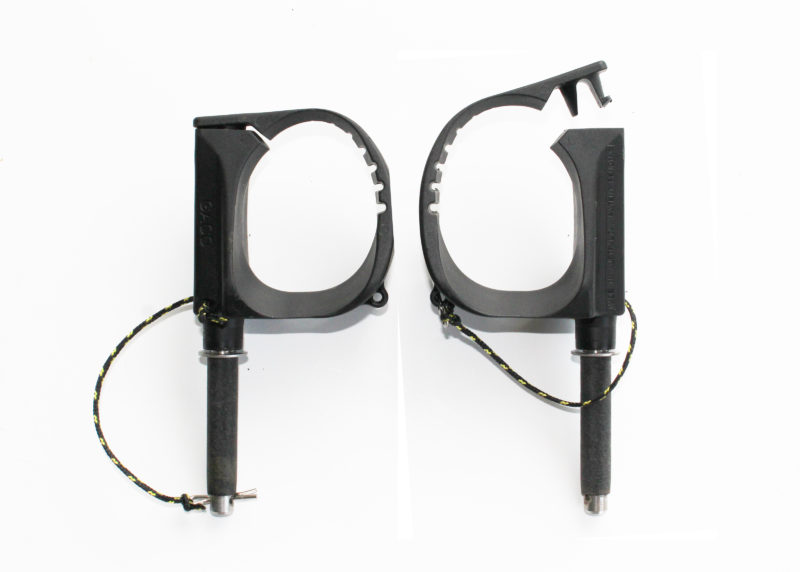
The locks open to be installed on oars. Sleeves installed over the pins adapt them to fit standard oarlock sockets.
The Gaco oarlocks fit oars up to 2 1/4″ in diameter (leathers included). You open the top of the lock by inserting a screwdriver in a slot to release the gate, making it possible to put the locks on oars with collars in addition to leathers. The Gacos are kinder to oar leathers than standard locks are. The bearing surface of a #1 bronze oarlock is about 1/2″ wide and has a radius of 7/16″, so the pressure on the leather is quite concentrated. The Gaco’s bearing surface is 1 3/4″ wide and almost flat. That should keep leathers from getting compressed and make them last longer. The vertical axis of the Gaco’s oval shape allows for the movement of the oar as the blade moves up and down during the stroke, and the horizontal axis is short to eliminate the slop of looms sliding back and forth.
In my rowing trials the Gacos worked well. They were quiet and smooth. A short lanyard and hitch-pin clip was included with each lock. The clip is can be inserted in the hole at the bottom of the pin to keep the lock in the socket, but the boat I used for testing had too much depth in the oarlock pad and the inwale to allow me to do that. I doubt I’d use it anyway. If a wave hits an oar blade hard enough to pop the lock out of the socket, I’d rather have that happen than have the handle driven down hard against my leg.
I quickly warmed up to the Gaco locks. They’re inexpensive and do their job well. While I was rowing I wasn’t aware of them at all, and that’s the best compliment I can offer any oarlock.![]()
Christopher Cunningham is the editor of Small Boats Monthly.
Gaco oarlocks are made in Australia and available direct from the manufacturer: $25 for the plain version, or $29 for the version reviewed here with the lanyard and clip.
Is there a product that might be useful for boatbuilding, cruising or shore-side camping that you’d like us to review? Please email your suggestions.
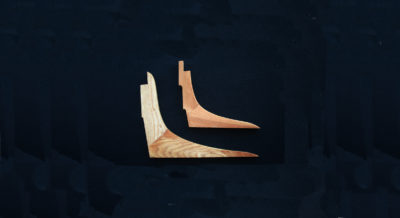


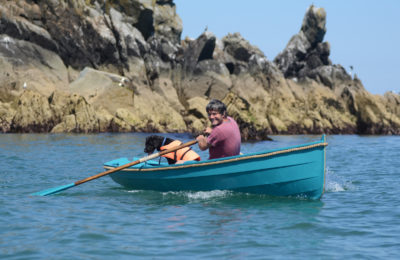
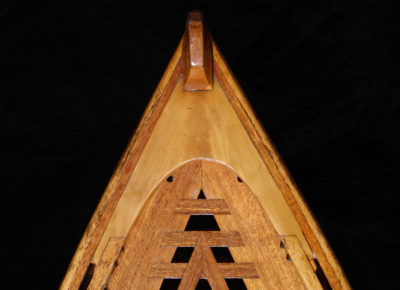
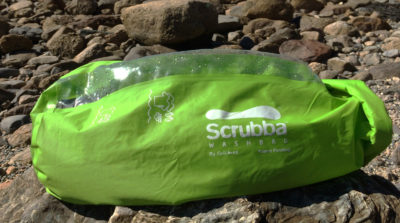
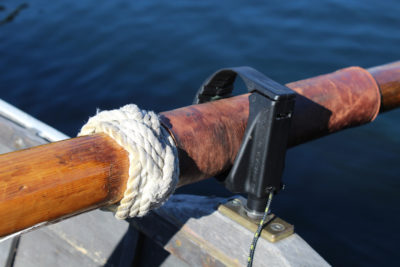

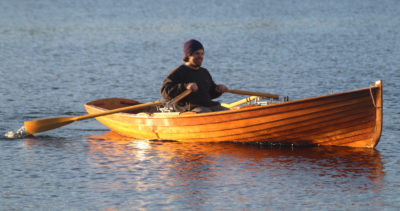
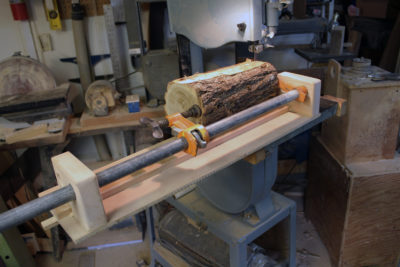
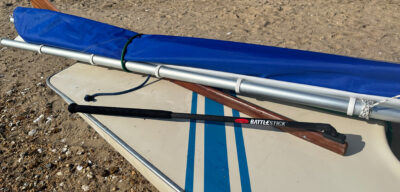

Can you reverse row—push against the strap away from the pin—at full pressure, or do you have to stop and turn them around for forward facing rowing?
I did some sudden stops and rowed backwards and the locks did fine when I put the pressure on the side of the lock opposite the pin. The molded plastic is very stiff and the latch is quite secure.
Technology catching with ancient methods. How does it compare to the obviously sharply honed technology on racing shells?
The locks used on racing shells date back at least to a patent (165,072) filed in 1874.That racing lock, and subsequent forms of it, had a gate at the top that opened to let the oar in. That’s necessary for a lock fixed to the outrigger. In a racing shell the gate has to be easily operated with one hand. The Gaco’s “gate” requires a screwdriver and both hands to open. Because the lock stays with the oar and not the boat, the gate doesn’t need to be opened. Aside from that, the oval opening in the Gaco lock is designed for round looms. Racing-shell locks are designed for a D-shaped cross section. The racing-shell lock has an external post to support the lock; Gaco’s post is internal. Aside from the structural differences, the function—putting the rotation forward of the oar, rather than underneath it—is similar.
If you look at the Gaco website you’ll find they also make carbon-fiber spoon blades for oars and suggest constructing shafts for them with a D-shaped cross section (actually more of a trapezoid with rounded corners) for use with their oarlocks. I have a set of their oarlocks that I use with oars with a D-shaped cross section and they work well. I also have a set of their spoon blades but have not yet completed the rest of the oars.
I’d also like to say that Gaco has great customer service and fast shipping even though they are based in Australia.